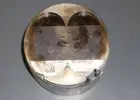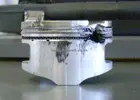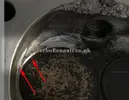Another option might be a supervised strip and inspection. Common in the industry i work in not sure about in the motorsport industry (it is in certain applications) where a professional attends their place of work and over sees one of the employees striping the failed components
There is more to life with TurboRenault.co.uk
You are using an out of date browser. It may not display this or other websites correctly.
You should upgrade or use an alternative browser.
You should upgrade or use an alternative browser.
5 GT Turbo EFI - GT Turbo
- Thread starter Mark Davis
- Start date
Clarkey
Well-Known Member
Yeah let me know if you know of anyone local re head. Yeah will ask Mark to check everything possible with block etc.
I would like to think CTM would sort the engine for you if the dropped valve guide has destroyed the engine.........
DaveL485
Staff member
Agree with Adey, this is a complete stripdown and rebuild of the full lump, with foreign objects rattling about that all needs breaking down to bare components and washing out thoroughly. It only takes one badly positioned bit of swarf to start a snowball effect that will spin a big end or run a cam journal.
I'd also insist on a full set of new valves, guides and collets. The springs should be OK. I would be concerned the head is scrap, not so much cos of the damage in the cylinders but the effect the dropped and slipped guides may have had, also as the bits dropped into the cylinder it might have chomped the valve seats.
I would probably even suggest to CTM they start over on a fresh head, rather than repair one thats been through a pretty spectacular failure.
I'd also insist on a full set of new valves, guides and collets. The springs should be OK. I would be concerned the head is scrap, not so much cos of the damage in the cylinders but the effect the dropped and slipped guides may have had, also as the bits dropped into the cylinder it might have chomped the valve seats.
I would probably even suggest to CTM they start over on a fresh head, rather than repair one thats been through a pretty spectacular failure.
Mark Davis
Brapmaster extraordinaire
Yeah will get Mark to do the works with the engine, I had never planned just to swap failed components. I have already ordered pistons, liners and rings though plus the 270 cam. Waiting to see if I already have vernier before buying a new one.
If i need to source a new block to work from I will. There is a standard fresh build on ebay for £400, tempting.
I've spoken to CTM this morning, head is being picked up by UPS today for delivery tomorrow. He said he will inspect and call me back later in the week. I explained the situation but he clearly didn't want to commit to if the guide failed first or as a result of det causing extra heat and then failure ? Who knows, I'm inexperienced with all this stuff.
He does sound genuine though but haven't discussed who's covering what and how much and like you say Dave if the head is scrap or not. If the head is scrap I think I would just source a standard head and fit springs, with the gains I made I'm not sure another £1000 is warranted.
I'd be pissed if the same thing happened again on a new build. At that point the car would be broken for parts and i'd move on, starting to lose patience with it all to be honest.
If i need to source a new block to work from I will. There is a standard fresh build on ebay for £400, tempting.
I've spoken to CTM this morning, head is being picked up by UPS today for delivery tomorrow. He said he will inspect and call me back later in the week. I explained the situation but he clearly didn't want to commit to if the guide failed first or as a result of det causing extra heat and then failure ? Who knows, I'm inexperienced with all this stuff.
He does sound genuine though but haven't discussed who's covering what and how much and like you say Dave if the head is scrap or not. If the head is scrap I think I would just source a standard head and fit springs, with the gains I made I'm not sure another £1000 is warranted.
I'd be pissed if the same thing happened again on a new build. At that point the car would be broken for parts and i'd move on, starting to lose patience with it all to be honest.
Mark Davis
Brapmaster extraordinaire
DaveL485
Staff member
I have never seen a correctly fitted guide fall out due to det. That shouldn't even be on the cards as an option.
I've never seen a valve guide fall out on ANY Renault engine from that era, PERIOD.
And believe me, i've seen some super duper uber mega fucked ones.
Mark Davis
Brapmaster extraordinaire
So then lads, now we have all seen the various pieces of evidence what does your experience tell you?
We know for sure the valve guide failed, we know it snapped and mashed around, we know the valve stem seal also dislodged and lost spring. We've seen pictures of squish pads and their damage and the amount of damage to pistons. Why 1, 3 and 4 but not 2?
Is everyone is general agreement that valve guide failure is the ONLY cause of failure? Although Chris did map it too lean for certain peoples like (12.1) he did so with full control on roller, det cans, control of fuelling/ignition not to mention the previous map AFR's were the same before I decided to fuck with head. (and didn't miss a beat) His experience and knowledge has me 100% convinced it wasn't down to his mapping.
I'm going to be having a few discussions with CTM over the next couple of days and want to make sure I am in a strong position so I am not a push over.
Cheers all.
We know for sure the valve guide failed, we know it snapped and mashed around, we know the valve stem seal also dislodged and lost spring. We've seen pictures of squish pads and their damage and the amount of damage to pistons. Why 1, 3 and 4 but not 2?
Is everyone is general agreement that valve guide failure is the ONLY cause of failure? Although Chris did map it too lean for certain peoples like (12.1) he did so with full control on roller, det cans, control of fuelling/ignition not to mention the previous map AFR's were the same before I decided to fuck with head. (and didn't miss a beat) His experience and knowledge has me 100% convinced it wasn't down to his mapping.
I'm going to be having a few discussions with CTM over the next couple of days and want to make sure I am in a strong position so I am not a push over.
Cheers all.
Fordy
Well-Known Member
If the car was too lean the Pistons would of been cleaner, all of them are uniform in colour black
Flat 12 afr is safe with correct timing, remember you've got a better fuel atomisation to each cylinder because of the fuel injectors.
Most people's opinions of fuelling is based on a carb and aei with too much timing and paired with piss poor mixture control between cylinders, where on a Carb'd = an 12afr is an average of 2 rich cylinders and 2 lean cylinders.
Chris has tuned these cars for years I'd not doubt his abilities.
This is the 2nd time I've seen a valve guide drop issue on a 5 head and the other one was on Phil on Rtoc few years ago.
I'm not surprised at CTM's reply, next time you hear from them will be "a combination of too much heat and det caused the problem we need more money's" I bet
Flat 12 afr is safe with correct timing, remember you've got a better fuel atomisation to each cylinder because of the fuel injectors.
Most people's opinions of fuelling is based on a carb and aei with too much timing and paired with piss poor mixture control between cylinders, where on a Carb'd = an 12afr is an average of 2 rich cylinders and 2 lean cylinders.
Chris has tuned these cars for years I'd not doubt his abilities.
This is the 2nd time I've seen a valve guide drop issue on a 5 head and the other one was on Phil on Rtoc few years ago.
I'm not surprised at CTM's reply, next time you hear from them will be "a combination of too much heat and det caused the problem we need more money's" I bet
Mark Davis
Brapmaster extraordinaire
I'm not surprised at CTM's reply, next time you hear from them will be "a combination of too much heat and det caused the problem we need more money's" I bet
This is my feeling too at which point I need to make a decision which way to go.
1) Go public and cause a nuisance of myself.
2) Take a legal route - (somehow) - Sister is a lawyer in one of London's top firms so no real fees for me (bonus)
3) Take it on a chin and write a grand off and put it down to experience.
4) Find another head, keep it standard barring springs. (probably my favoured route)
Clarkey
Well-Known Member
3) Take it on a chin and write a grand off and put it down to experience.
This is not an option !!!!!
As for the fuelling we used to run 12.5 AFR on carb with no issues, we only used to run 17/18 psi.
On EFI and 21 psi we are also low 12's now.
Last edited:
DaveL485
Staff member
If this were my car, i'd be leaning hard on CTM to fix the valve damage on the head at the very least. Thats a serious mechanical failure even if it did get hot.
I still think the bent pushrod might have been caused by the valve sticking in the guide, that could contribute to it being pushed out of the head too.
I'd still also be checking out EVERYTHING like sensors, fuelling system for evidence of problems. I'm amazed this would happen so soon after mapping, without something badly wrong the only thing I could attribute it to is your overboost situation when it hit the cut but even so for the limited time it happened the damage is tremendous.
Remember the key differences here for your discussions too (plagiarised from an article I read): Detonation is the spontaneous combustion of the end-gas (remaining fuel/air mixture) in the chamber. It always occurs after normal combustion is initiated by the spark plug. The initial combustion at the spark plug is followed by a normal combustion burn. For some reason, likely heat and pressure, the end gas in the chamber spontaneously combusts. The key point here is that detonation occurs after you have initiated the normal combustion with the spark plug. You can typically expect to see evidence in the part of the chamber most distant from the spark plug, because if you think about it, you would ignite the flame front at the plug, it would travel across the chamber before it got to the farthest reaches of the chamber where the end gas spontaneously combusted.
Detonation causes three types of failure; Mechanical damage (broken ring lands), Abrasion (pitting of the piston crown), Overheating (scuffed piston skirts due to excess heat input or high coolant temperatures).
I still think the bent pushrod might have been caused by the valve sticking in the guide, that could contribute to it being pushed out of the head too.
I'd still also be checking out EVERYTHING like sensors, fuelling system for evidence of problems. I'm amazed this would happen so soon after mapping, without something badly wrong the only thing I could attribute it to is your overboost situation when it hit the cut but even so for the limited time it happened the damage is tremendous.
Remember the key differences here for your discussions too (plagiarised from an article I read): Detonation is the spontaneous combustion of the end-gas (remaining fuel/air mixture) in the chamber. It always occurs after normal combustion is initiated by the spark plug. The initial combustion at the spark plug is followed by a normal combustion burn. For some reason, likely heat and pressure, the end gas in the chamber spontaneously combusts. The key point here is that detonation occurs after you have initiated the normal combustion with the spark plug. You can typically expect to see evidence in the part of the chamber most distant from the spark plug, because if you think about it, you would ignite the flame front at the plug, it would travel across the chamber before it got to the farthest reaches of the chamber where the end gas spontaneously combusted.
Detonation causes three types of failure; Mechanical damage (broken ring lands), Abrasion (pitting of the piston crown), Overheating (scuffed piston skirts due to excess heat input or high coolant temperatures).
Pre-ignition is defined as the ignition of the mixture prior to the spark plug firing. Anytime something causes the mixture in the chamber to ignite prior to the spark plug event it is classified as pre-ignition. The two are completely different and abnormal phenomenon. Failure wise you expect a hole in the middle of the piston, particularly a melted hole in the middle of a piston, due to the extreme heat and pressure. Other signs of pre-ignition are melted spark plugs showing splattered, melted, fused looking porcelain. Often it will melt away the ground electrode.
Last edited:
DaveL485
Staff member
I think know what this is - assuming this is the valve where the guide dropped out completely, that shiny damage is where the valve itself has opened and then closed out of position, look at the shape of the damage, it follows the shape of the valve edge. I bet thats where the back side of the valve dug into the head.
DaveL485
Staff member
Is everyone is general agreement that valve guide failure is the ONLY cause of failure?
No because it doesn't explain all of the cylinders being fried. I'm also confused as to why the inlet valve guides dropped, if the heat from det was responsible it'd be the exhaust valves, surely.
I'm struggling to sequence things in my head, I can't create a scenario that works where we can get to [event1] caused [event2] and so on to [engine destruction].
I'm half expecting more bits to the jigsaw puzzle to appear.
Mark Davis
Brapmaster extraordinaire
The damage on the squish pad areas? Det or damage by foreign matter?
I'm with dave I'm expecting to see further damage or missing parts from the head. To me there might be det there but usually it runs down the side of the pistons too but we can't see that.
I'm wondering if the damage was to one cylinder originally. Then the valve been held open caused debris to be pushed back into the inlet and the back down into the other cylinders. Im not saying there a no det damage either just to me it's still foreign material. Also this damage would still be limited to the squish areas as that's where it's caused interference. There would be no damage to the rest of the piston or the chamber if the foreign matter is smaller than the space available. It would also only take a little damage to create more resulting damage.
After thinking of it this way I'm going with part failure as my answer, any det damage would then be the result of the damage by materials causing hot spots.
I'm wondering if the damage was to one cylinder originally. Then the valve been held open caused debris to be pushed back into the inlet and the back down into the other cylinders. Im not saying there a no det damage either just to me it's still foreign material. Also this damage would still be limited to the squish areas as that's where it's caused interference. There would be no damage to the rest of the piston or the chamber if the foreign matter is smaller than the space available. It would also only take a little damage to create more resulting damage.
After thinking of it this way I'm going with part failure as my answer, any det damage would then be the result of the damage by materials causing hot spots.
Last edited:
Mark Davis
Brapmaster extraordinaire
If you look at piston number 3 you can see signs of it looking like the piston that Red21 posted up. I am dropping the engine to Mark the week in between Xmas and New year so we will see.
Similar threads
- Replies
- 4
- Views
- 345
- Question
5 GT Turbo
Renault 5 1700cc kit
- Replies
- 23
- Views
- 392
- Question
5 GT Turbo
Renault 5 gt turbo radiator options
- Replies
- 13
- Views
- 185
- Replies
- 0
- Views
- 185




